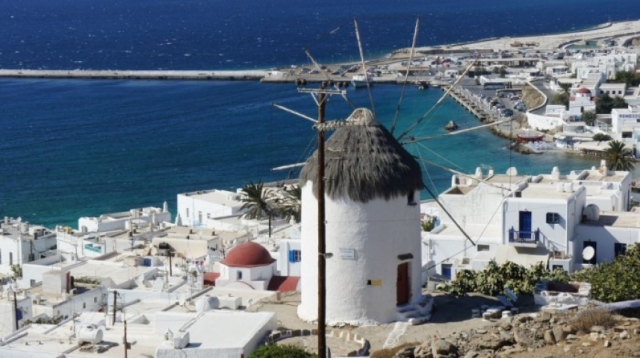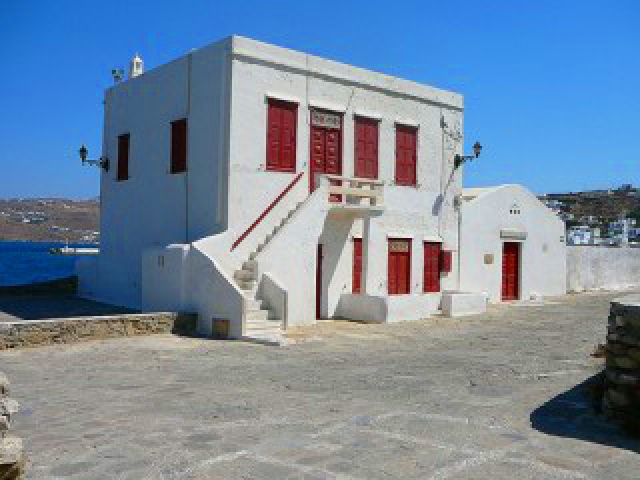Press here.
Places near Church
In the Kastro, which is the original nucleus of the present-day town of Mykonos (on its northwestern edge), stands the Paraportiani, a group of building impressive for its shapes' plasticity.
Historic religious sites on Mykonos can also be found along the coastline, and Panagia Paraportiani is one of them. Located at the entrance to the Kastro neighborhood of Chora, the whitewashed walls of this seaside church form a unique shape due to the building’s unusual construction. Five small churches that were built on top of each other beginning in the 14th Century became the Panagia Paraportiani that can be seen today. The asymmetrical shape and rare combination of architectural styles combined with the ocean view have helped to make Panagia Paraportiani one of the most photographed sites in the world.
In this location, during the Middle Ages, there was a tall, fortified tower, side by side and above one of the entrances to the Kastro. Now there is a complex made up of five churches altogether, four on the ground level and on the floor above, the church of the Virgin, which is the oldest of all. The Paraportiani, and the windmills are the island’s trademark.
Among the attractions of Mykonos, Mills are the trademark of the island with the old Bonis Windmill being the most distinctive one. Bonis Windmill, one of the Upper Mills (Apano Myli), dates most likely from the 16th century.
This mill, originally belonged to the old Mykonian family of Bonis, the Mykonian windmill is a stone-built three-storey and cylindrical construction. The ground floor is used for the collection and weighing of the grain. The flour is collected on the middle floor, while there is an ancient milling machine on the second floor. The sail-wheel of Bonis Windmill has twelve wooden spokes with the same number of triangular sails.
Agriculture Museum
The Agricultural Museum of Mykonos was established subsequently to the 1st Symposium of the Folklore Museums of Greece, which was held in Mykonos in1984. It serves the idea of an outdoor museum, which includes as its exhibits the Bonis Windmill and some other newer facilities, such as the threshing floor, the dovecote and the oven. The Windmill, the threshing floor and the oven are the tree rural installations that for centuries have provided the locals with bread, the most significant part of their everyday diet.
The intention of the Agricultural Museum is to preserve the autonomous rural farmhouse, typical of what once was such a vital aspect of rural life in Greek islands. Also, at the Agricultural Museum of Mykonos one can see tools and machines from the pre – industrial and early industrial eras, which were used in the past for the production and processing of agricultural products.
The museums centerpiece is the Boni Windmill, which is in full working order and may be visited from June to September daily, 4:00-8:00 p.m. (tel.: +30 22890 – 26 246).
Lena's house, near the Three Wells, is a charmingly preserved, authentic 19th century Mykonian middle-class dwelling, which is completely furnished and equipped with antique furniture and house utensils.
Open evenings, except Sundays, from April to October, 6:30p.m. to 9:30p.m.
Mykonian Folklore museum of Mykonos Island Greece.
The beneficial to the public institution "Mykonian Folklore Collection" was founded by Professor Vasilios Kyriazopoulos on May 1958. The museum is situated at Castro, in a 18th century building. In there, are exposed museum articles sorted by subject.
Keys and locks collections, handwoven tapestries, painted plates, old weights and measures, traditional Cycladic sculptures and lighting devices ranging from the ancient oil to the kerosene lamp.
Obsedian tools and weapons representing the interior of a 19th century middle class drawing room.
A 19th century bedroom.
A 19th century kitchen.
Around the "Mermelechas well"- a known pirate there are large and small traditional Aegean ship models, cannons and pictures of old Mykonian sailing and steamships.
The Museum is open from April till October from 17:30-20:30 every day and from 18:30-2:30 on Sundays. Telephone contact on (0289-22591/22748) No admission charge.
The Agricultural Museum is situated at Ano Mili (Up Windmills) in the town of Mykonos. It is a branch of the Folklore Museum and hosts installations for the processing agricultural products on the island before industrialization. The large "Bonis" -after the captain- windmill, which dates since 16th century is a listed building, a traditional threshing-floor and a village style oven, the wine-press, a water wheel, a stone water tank, dovecote, pigsty, the miller"s house and two little twin churches. There is also a collection of old agricultural tools and machinery. The museum is open from June till 30th September, between 16:00-20:00 daily. Telephone : (+30) 22890 22591-22748. No admission charge.
Lena's House
Lena’s House, being a typical 19th Century Mykonian town hoyse, is one of the annexes of the Mykonos Folklore Museum. It was named after its last occupant, Lena Skrivanou and is a single-storey building of the 19th century complete with its antique furnishings, located at Tria Pigadia in Hora. It functions as an autonomous museum and it is open to the public, while one can get a taste of a typical middle-class house of the 19th century Mykonos.
The floor plan of this house is typical of its period. At the front, there is a large main room with a wide arch at the centre supporting the roof. Going further in, there are two smaller rooms. At the back of the house, there is a service room and also two small courtyards, with a replica of a dovecote.
The original furnishings of the house, all of the 19th Century or older, have been enriched by the donors and the Folklore Museum itself with the addition of several items of a modern period. There one may see an interesting collection of European and domestic furniture of 19th century in their regular position and also useful and decorative pieces of its household.







